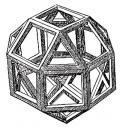Clairvoyance
From The Art and Popular Culture Encyclopedia

This page Clairvoyance is part of the mysticism series.
Illustration to the Speculum Sophicum Rhodostauroticum (1618) by Teophilus Schweighardt Constantiens
Illustration to the Speculum Sophicum Rhodostauroticum (1618) by Teophilus Schweighardt Constantiens
,_Utriusque_cosmic_maioris_scilicet_et_minoris_metaphysica.jpg)
17th century representation of the 'third eye' connection to the 'higher worlds' by alchemist Robert Fludd.
Utriusque cosmi maioris scilicet et minoris metaphysica by Robert Fludd
Utriusque cosmi maioris scilicet et minoris metaphysica by Robert Fludd
|
Related e |
|
Featured: |
The term clairvoyance (from French clair meaning "clear" and voyance meaning "vision") is used to refer to the ability to gain information about an object, person, location or physical event through means other than the known human senses, i.e., a form of extra-sensory perception. A person said to have the ability of clairvoyance is referred to as a clairvoyant ("one who sees clearly").
Claims for the existence of paranormal and psychic abilities such as clairvoyance have not been supported by scientific evidence published in high impact factor peer reviewed journals. Parapsychology, including the study of clairvoyance, is an example of pseudoscience.
[edit]
See also
- Anomalous cognition
- Astral projection
- Aura
- Channeling (mediumistic)
- Chizuko Mifune
- Etheric body
- List of parapsychology topics
- Near-death experience
- Out-of-body experience
- Paranormal phenomena
- Parapsychology
- Plane (esotericism)
- Postdiction (retroactive clairvoyance)
- Precognition
- Remote viewing
- Schizophrenia
- Spirituality
- Subtle body
- Third eye
- Visionary
Unless indicated otherwise, the text in this article is either based on Wikipedia article "Clairvoyance" or another language Wikipedia page thereof used under the terms of the GNU Free Documentation License; or on research by Jahsonic and friends. See Art and Popular Culture's copyright notice.

